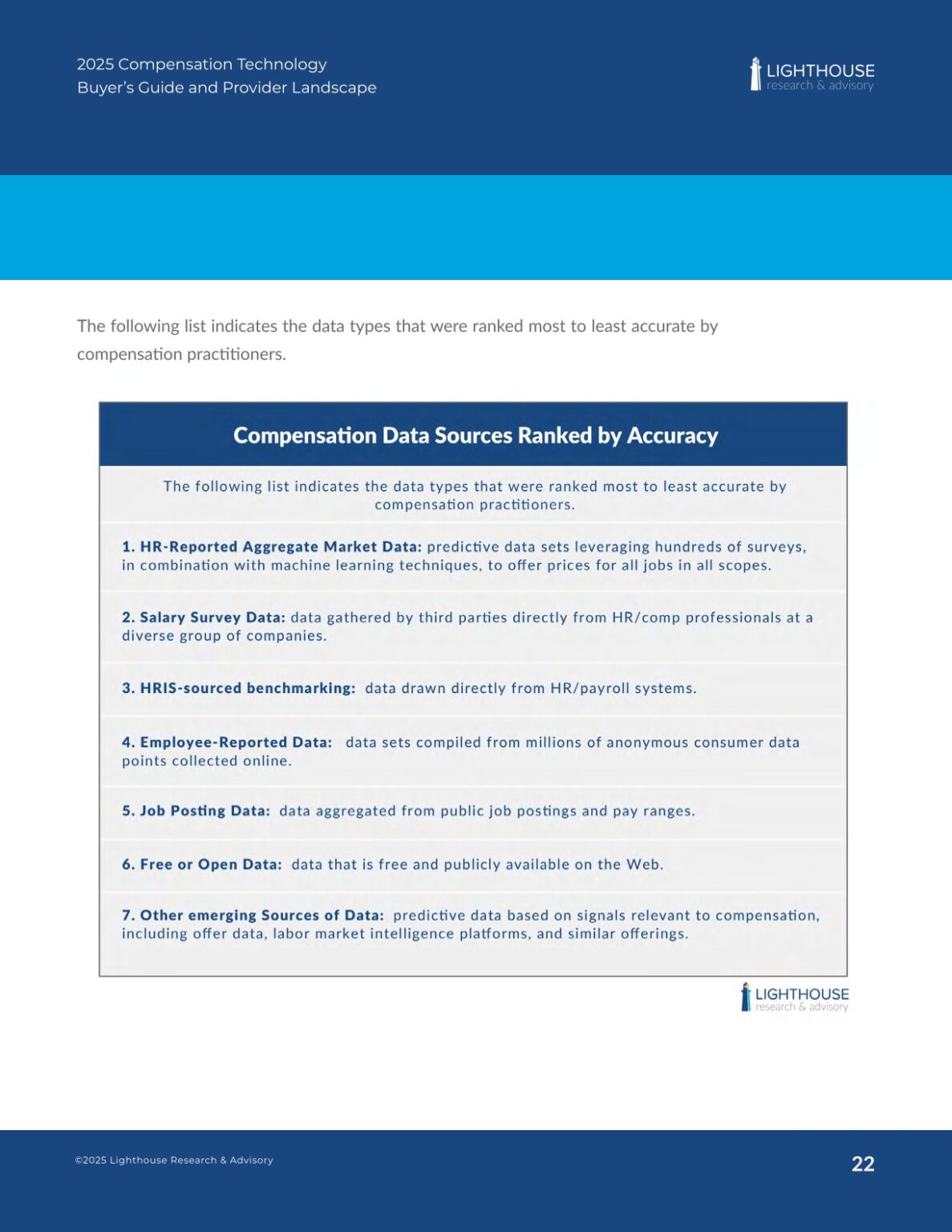AI is Changing Work (and Compensation isn’t Immune)
Since 2019, our team has analyzed the changes in compensation technology and data usage along with key trends that influence the near-term and long-term view of the compensation function. In all that time, no other trend or theme has seemed to have the same degree of potential as artificial intelligence technology. The emergence of this seemingly ubiquitous solution has changed facets of life and work in ways we could have never expected, and it’s one of the big themes in this year’s research.
This is the evolution as we’ve seen it over the last few iterations of this research:
2021 → Foundation and Acceleration
- Theme then: Organizational demand for compensation technology and data were on the upswing as employers struggled to compete for talent coming out of the pandemic. Recruitment and compensation were in a struggle between competitiveness, fairness, and reasonableness regarding pay.
- Key forces: Adoption of purpose-built compensation tools, comfort with employee-reported data, and legislative pressure on equity.
- Why it matters for 2025: This established the baseline — compensation became data-driven and tech-enabled, setting the stage for bigger strategic expectations.
2023 → Compensation as Strategy
- Theme then: Compensation shifted from being a back-office process to the anchor of workforce strategy.
- Key forces: Talent scarcity, pay transparency laws, and overlapping sources of market data. Vendors were no longer just automating cycles; they were positioning compensation as central to retention, mobility, and fairness.
- Why it matters for 2025: The idea of comp as a strategic lever paved the way for today’s conversations about integration with talent systems, CFO alignment, and year-round relevance.
2025 → AI, Integration, and Global Context
- Theme now: The emphasis is on how AI is transforming compensation (in various ways), how comp functions as a talent strategy enabler, and how data and transparency pressures continue to evolve.
- Key forces: AI shifting from “add-on” to “engine,” comp becoming embedded in hiring/retention strategy, persistent fragmentation in data sources, and regulatory drivers that are most pressing for global firms.
- Why it matters now: What started as a technology acceleration (2021) and matured into strategy (2023) has culminated in 2025’s focus: compensation as both an AI-enabled decision system and a strategic talent management driver, with data and regulation shaping the execution.
Download the new report
This continuing evolution is both thrilling and concerning. On one hand, the demand for well-equipped, passionate compensation leaders has never been higher. On the other, AI is being overlaid on a function that has very human impacts, which means we have to be vigilant about how, when, and where it gets implemented.
In a recent keynote, I shared three of the areas where modern, forward-thinking compensation teams set themselves apart from the pack.
We have new data sources for more timely and accurate pay insights: job posting data, competitive offer data, and even straight HRIS integrations. Surveys are still holding strong as a source of compensation truth, but employers are looking for more real-time insights in the always-on world we’re living in today.
- Creative: more and more, employers are using innovative strategies to redesign pay that attracts and retains top talent
One VP of HR shared a story about turnover issues at their financial services company. The assumption from management was that pay was not competitive, but an analysis showed that it was. However, the problem was with the broadbanding approach to pay. Essentially, when an employee took the job they could have the same title for their entire tenure at the company, so there was no motivation or sense of progress.
The compensation team broke the job into a series of steps and commensurate pay ranges without increasing pay overall. The result: an immediate and sustained impact to employee retention and satisfaction! That’s what it means to approach compensation creatively.
- Connected: compensation work may have been done in a silo in the past, but today the function has to be connected in order to have real impact…That means connected to key behaviors, connected to company values, and connected to the desires of the workforce as well.
One easy example: in our 2025 Talent Acquisition Trends Study of 1,000 job seekers, we found that the majority of them said that they would expect to be paid more money if they took a job with no growth, training, or development. Compensation is connected to so many different things, and employers must use comp not just as a lever for individual performance but as a linchpin for strategy and business outcomes.
Those aren’t just hopeful statements—they are backed up by real data.
In the 2025 Compensation Technology and Data Trends Study of over 700 different companies, one of the new areas we explored was the development of the skills and competencies within the compensation function and how those capabilities are evolving over time. Based on the data, these are the top three ways that compensation professionals expect the role/function to change in the next three years:
- More integrated with other HR/reward functions – 60%
- More focused on data analytics – 55%
- More involved in business strategy – 47%
These data points show that compensation must change from a siloed, tactical approach to a strategic, connected one.
It’s often been said, “If you want to go fast, go alone. If you want to go far, go together.” Compensation teams and leaders have to be ready to “go together” with their internal stakeholders. The stakes are too high to leave this to chance.
From a technology perspective, this analysis has grown every time we have evaluated the market. We reached out to dozens of firms and secured briefings and demos with the majority of them. The resulting insights on those technology solutions are woven through this report and can be found in a deep dive at the end in the Technology Landscape section.
A challenging requirement of writing this report is doing so in a way that meets the needs of a varied audience. That said:
- If you are new to compensation or new to compensation technology and data usage overall, this guide will offer an in-depth look at the bigger market, the key players, and the trends you need to know. There are helpful tips as well for first-time buyers of these solutions sprinkled throughout this report.
- If your organization is using compensation technology and data already, expect to learn something new about how technologies and data sources are evolving. Look for ideas that can help you level up your organization’s maturity and create a more aligned, strategic function.
- If you have a well-designed, strategic compensation function and are aligned to your business, consider some of the data points on high performers that might offer insight on how to move to higher levels of success. Additionally, pay close attention to the future-oriented data points like those above related to the evolution of the compensation role. Those offer a preview of what’s coming around the curve and how to help your organization prepare.
Fundamentally, this report is about technology and data, arguably two of the most mechanical and dry topics that one might select (even for those of us that love data!)
However, this is also a report about people like you that are serving in a wide variety of organizations, industries, and positions. It’s both a reminder of the far-reaching effects of the work we do as compensation professionals, and it’s also a call to action as we work to elevate ourselves and our impact in the workplace.
While compensation teams may not get applause and celebration at work for the problems they solve, the creative ideas they try, or the people they serve, we know the excellent work that goes on behind the scenes every day. Compensation is crucial to individual success and organizational success overall, period. It’s what the research indicates time after time, and this year’s findings serve as definitive proof of that fact.

Ben Eubanks is the Chief Research Officer at Lighthouse Research & Advisory. He is an author, speaker, and researcher with a passion for telling stories and making complex topics easy to understand.
His latest book Talent Scarcity answers the question every business leader has asked in recent years: “Where are all the people, and how do we get them back to work?” It shares practical and strategic recruiting and retention ideas and case studies for every employer.
His first book, Artificial Intelligence for HR, is the world’s most-cited resource on AI applications for hiring, development, and employee experience.
Ben has more than 10 years of experience both as an HR/recruiting executive as well as a researcher on workplace topics. His work is practical, relevant, and valued by practitioners from F100 firms to SMB organizations across the globe.
He has spoken to tens of thousands of HR professionals across the globe and enjoys sharing about technology, talent practices, and more. His speaking credits include the SHRM Annual Conference, Seminarium International, PeopleMatters Dubai and India, and over 100 other notable events.

